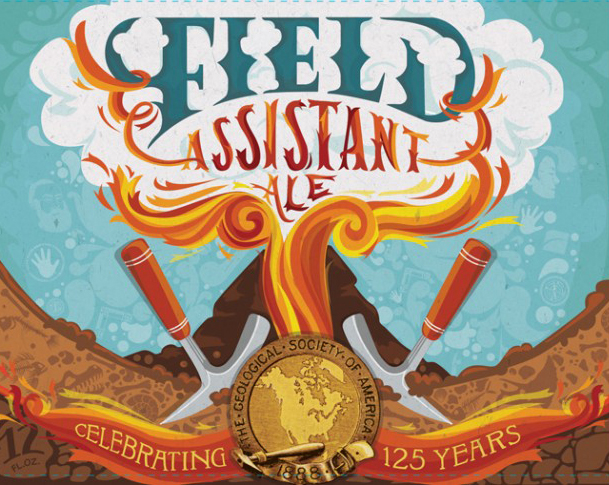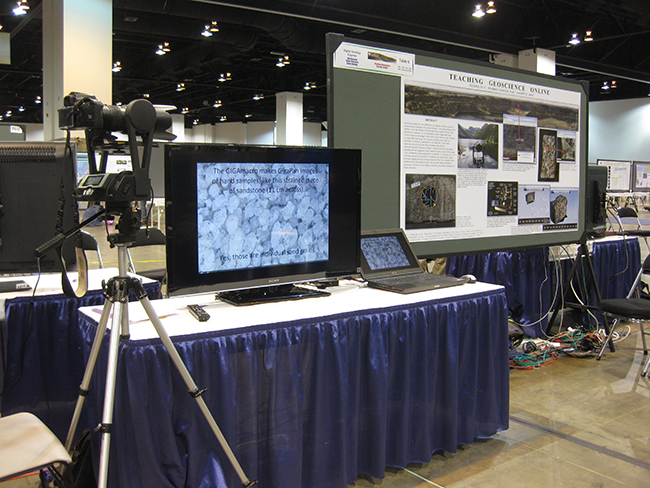These annual meetings of the Geological Society of America seem to fly by faster and faster. I’ve found that, through the years and as my career has developed, that I have less and less time for attending talks or contemplating research presented on posters. Instead, I spend my time sharing my own work, supporting students, networking and catching up with colleagues, and attending meetings for various groups and projects. Less absorption, in other words, and more activity.
As soon as I stepped off the plane Saturday, I headed straight for the Tivoli Student Center on the Auroria campus – a multi-college shared campus downtown, not too far from the convention center. It’s an old converted brewery, which gives it a really cool outside appearance, and a labyrinthine interior – it’s one of those buildings with short little staircases connecting proper “floors” to other levels, between the main floors. There, in the short course on student success at two-year colleges, I found a who’s who of the two year college geoscience scene – many familiar faces and old friends. Over the course of the day, I got to meet some new people, too, including Alan Cutler of Montgomery College in Maryland, a compatriot on the DC-Metro geology scene who I’ve heard a lot about, but had never previously met. Several people came up to me to express their appreciation for the SmartFigures that I produced last year for the 11th edition of Tarbuck and Lutgens’ Earth. As far as the actual content of the short course, I got some new insights into math anxiety, supporting veteran students, and even how the principles of group therapy can be applied to the classroom. Many of my colleagues are dabbling with exciting new pedagogical techniques, and it’s a key benefit of attending sessions like this to get exposure to (a) those ideas and (b) the fact that other people are actually doing them now.
In the latter portion of the session, I thought about a particular problem that I would like to see solved in my classes, and found myself mulling over the lack of racial and ethnic diversity in the geosciences. I came up with an action plan that’s more exploratory than definitive, so while it’s not as well-delineated as I would like, I feel like I’ve got some clear starting steps I can take to move forward.
As an aside, I had a conversation last night about the issue of diversity in the geosciences. One of my conversants raised the question: why are we as Americans so hung up about race? This person had spent time overseas, and remarked how unusual the U.S. custom of constantly assessing race is. Why should we be pushing for increased racial or ethnic or gender diversity, the thinking went. Why not just let people do whatever they want to do? While I think the ultimate point of this observation – that race is a valueless human construct – is entirely valid, that doesn’t mean that racism isn’t real. Inequality is still demonstrably is a major force in our society, and therefore helps steer the course of individuals’ lives, whether they want to be steered or not. I guess my thinking in response is that the point of making an effort to increase the number of students and professionals from underrepresented groups is not an end in itself. The point is to remove (or at least, counteract) those societal currents that push people where they don’t want to go. If they don’t want to be a geoscientist, fine. But if they do want to be a geoscientist, then I want to make sure they have that opportunity.
That evening, I made an appearance at the big “icebreaker” reception, but because I was hauling a huge bag (my luggage), I didn’t feel like I could mix and mingle very well. So I played the part of the wallflower, and that’s fine by me. I enjoyed one of the newly-released beers from Left Hand Brewery, the Field Assistant Ale. It was a tasty quaff, and it bore a lovely label:

Then it was time for a pre-meeting meeting with my fellow PIs on the GEODE grant, Steve Whitmeyer and Declan De Paor. We plotted out what we wanted to do at our project meeting an hour later, and also a strategy for our digital poster the following day (also about GEODE).
Then we met with our colleagues on the grant, including GigaPan luminaries Ron Schott and Bill Richards, who will be working with me on the gigapixel geoimagery part of the project. I was seriously tired at this point, having risen at 4am east coast time (2am Denver time), but managed to be coherent, I hope. It was good to see everyone face to face, a welcome sight after so many emails bandied back and forth over the previous year.
After that, I caught a taxi up the hill to my friends’ house, and had a beer with them as a way of reunion, and then headed straight to bed.
Sunday dawned and I rose, gathering up strings and pens for our poster’s suggestion notations areas (“scribble boxes”), downed some excellent coffee, then jumped on a loaner bicycle and spun my wheels downhill. It was nice to start the day with a bit of high-speed exercise.
I got my digital poster set up with Steve and Declan, and spent most of my non-otherwise-scheduled time in there, talking GigaPans and GEODE with interested passers-by.
I ducked out at 1pm to give my talk on the annual Rockies field course that I run with Pete Berquist, and made the case that we’ve hit upon a useful field experience that students appreciate, and that co-teaching it is the way to go. In addition, I outlined the institutional support network that makes the class possible – our collaborations with schools and foundations in the study areas. The talk was well received, I think. I got some laughs and good questions. Right after my talk, I was delighted to hear Amanda Colosimo and Jessica Barone presented another field course talk. The opportunity to compare and contrast the two approaches was a real benefit: it was an example of good scheduling on the part of the session organizers.
After checking in on the digital poster again, I returned to the same session and gave a talk for my colleague Shelley Jaye, who had had a sudden family emergency, and had left the meeting. So I quickly reviewed her PowerPoint and did a reasonable job (I think) presenting a summary of three key initiatives that she has developed at our institution. It’s the first time I’ve “subbed” a talk, and I can say that I enjoyed it – expectations for my performance were probably quite low, and so I was able to easily exceed them.
At 4pm, NOVA student Mercer Parker gave a talk in the undergraduate research session. He was talking about his work on describing the petrology of the lowermost portion of the Bayside Core, a USGS-drilled vertical sample into the Chesapeake Bay Impact Structure. NOVAians Jim Buecheler and Robin Rohrback and Rich S. and I were there to support Mercer’s efforts.

I slipped back into the geoscience education session after that, and caught Pranoti Asher’s (AGU) talk before zipping across the street to the Geo2YC division meeting (I had volunteered to act as meeting secretary in the absence of our regular secretary). After that concluded, it was into the NAGT-sponsored geoscience educators’ reception. There I met up with some old friends, and talked shop on many topics – from student drug use to the InTeGrate project to the ethics of sharing outcrop information. I had dinner with some of them, and then rode my bike back up the hill and got a decent 7 hours of sleep. Sleep is critical to making it through a marathon meeting like this. I don’t understand how some of my colleagues can go out and drink beer until midnight or 1am and then show up to the conference at the same hour as me, and more coherent than me to boot!
Now it’s Monday, and our big Digital Geology Express session has commenced. Here’s the scene at our demo area this morning:

If you’re here at GSA, we hope you’ll stop by and talk about these exciting technological developments and how they can be employed for geoscience education.

Speaking as one of the students you spend time supporting: thank you.
Wish I could have attended your presentation on Sunday, but I was on a GSA Field Trip all day. I teach at a community college in Illinois where we have been teaching a Gen-Ed, 100-level summer field course for the past thirty years. It is a cross-discipline class taught by both biology and geology faculty, and students can register for credit in either life science or physical science. We alternate destinations between the Grand Canyon and Yellowstone. Love to talk with more about your class and share some ideas.
Happy to talk about it sometime. Give me a call next week if you’d like!